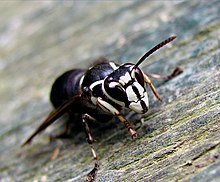This is a hornets nest growing at the back of the practice facility and out of harms way. It's not your typical hornet, however. These are black and white as opposed to yellow and black. I'm not too fond of bees of any kind but I looked them up to learn more about them.
| Bald-faced hornet | |
|---|---|
 | |
| Scientific classification | |
| Kingdom: | Animalia |
| Phylum: | Arthropoda |
| Class: | Insecta |
| Order: | Hymenoptera |
| Family: | Vespidae |
| Genus: | Dolichovespula |
| Species: | D. maculata |
| Binomial name | |
| Dolichovespula maculata | |
| Synonyms | |
Vespa maculata
| |
Dolichovespula maculata is a eusocial wasp of the cosmopolitan family Vespidae. Its colloquial names include the bald-faced hornet, bald hornet, white-faced hornet, white-tailed hornet, spruce wasp, blackjacket, and bull wasp. This species is a yellowjacket wasp, not a true hornet (genus Vespa). Colonies contain 400 to 700 workers, the largest recorded colony size in its genus, Dolichovespula.[1] It builds a characteristic large hanging paper nest up to 58 centimetres (23 in) in length. Workers aggressively defend their nest by repeatedly stinging invaders.[2]
Dolichovespula maculata is distributed throughout the United States and southern Canada, but is most common in the southeastern United States. Males in this species are haploid and females are diploid. Worker females can therefore lay eggs which develop into males. Matricide might occur after sufficient workers have been raised and queen-destined eggs have been laid, in order to give workers a reproductive advantage.[3]

